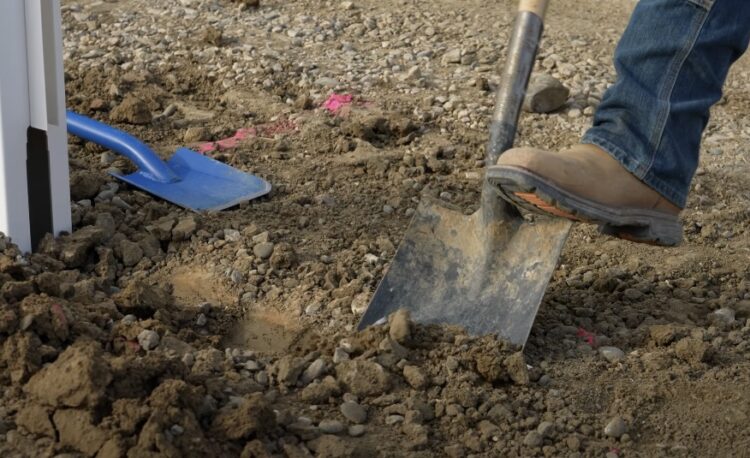In the world of gardening, the garden spade is an often-underestimated yet indispensable tool, with its sharp, flat blade designed for precise soil work. This guide explores its anatomy, types for specific tasks, and essential selection criteria. Additionally, we cover maintenance and safety tips, revealing the true versatility and importance of this humble garden companion.
What is a Garden Spade?
A garden spade, often considered the Swiss Army knife of gardening, is much more than just a tool; it is a gardener’s indispensable partner in the process of transforming soil into life. The key differentiator between a spade and a shovel lies in their shape and intended use. A spade features a sharp, flat blade that is perfectly suited for slicing through soil, making it particularly well-suited for tasks like edging, digging, and transplanting.
The Anatomy of a Spade
Understanding the anatomy of a spade is crucial to appreciate its functionality. A spade consists of three essential parts: the blade, the handle, and the footrest. Each of these components plays a distinct and pivotal role in the spade’s overall effectiveness.
- The Blade: The blade is the business end of the spade, where the real work happens. It is typically made from durable materials such as steel and comes in various shapes and sizes to cater to different gardening tasks. The sharp, flat edge of the blade allows it to efficiently cut through soil and roots;
- The Handle: The handle serves as the gardener’s guiding hand, providing control and leverage. It is usually made from wood or metal and is designed for a comfortable grip. The length and shape of the handle can vary, offering options tailored to individual preferences and ergonomic considerations;
- The Footrest: The footrest, often located at the top of the blade, is where the gardener’s strength meets the soil. It provides a stable platform for pushing the spade into the ground with minimal effort, allowing for more efficient digging.
Types of Garden Spades

Gardeners can choose from a variety of spade types, each crafted to excel in specific gardening tasks. Selecting the right type of spade can significantly enhance your gardening experience. Here are some common types:
- Digging Spade: This is the classic garden spade, ideal for digging, turning over soil, and planting. It typically features a rounded blade and a sturdy construction;
- Border Spade: A border spade is smaller and lighter than a digging spade, making it perfect for precision work like edging flower beds and creating clean lines in the garden;
- Trenching Spade: The trenching spade easily digs deep, narrow trenches. Its long, narrow blade allows precision trench digging for irrigation lines and edging;
- Transplanting Spade: This spade has a long, narrow blade with a pointed tip, ideal for digging and transplanting small plants with minimal root disturbance;
- Garden Spade Edger: As a special mention, the garden spade edger deserves recognition. It is like the fine brush in an artist’s toolkit, allowing gardeners to create sharp, professional-looking edges around flower beds and pathways. The garden spade edger is an essential tool for defining spaces and maintaining a neat and organized garden.
Choosing the Right Garden Spade
Selecting the perfect garden spade is akin to choosing a dance partner for your gardening endeavors. It’s essential to consider various factors to ensure a harmonious gardening experience. Here are key considerations when choosing a garden spade:
- Handle Length: The length of the handle is a critical factor that influences comfort and efficiency. Taller gardeners may prefer longer handles, while shorter handles can be more manageable for those of shorter stature. The handle should allow for a comfortable and natural grip;
- Blade Material: The material of the blade determines its durability and effectiveness. High-quality steel blades are renowned for their strength and longevity, making them a preferred choice for serious gardeners;
- Weight: The weight of the spade is another factor to ponder. A balance between weight and durability is crucial. A spade that is too heavy can lead to fatigue during extended use, while one that is too light may lack the necessary strength for challenging tasks.
Maintenance and Care for Spades
To ensure your garden spade continues to serve you well, proper maintenance and care are essential. Here are some fundamental steps to prolong the life and efficiency of your spade:
- Cleaning: After each use, it’s advisable to clean off dirt and debris from the blade to prevent corrosion and maintain its sharpness;
- Sharpening: Periodically sharpen the blade to ensure it cuts through soil effortlessly. A sharp blade reduces the strain on the gardener and enhances productivity;
- Proper Storage: Store your spade in a dry and sheltered location to protect it from the elements. Hanging it on a wall or using a dedicated storage rack can help prevent damage and rust.
Safety Tips When Using a Garden Spade

While using a garden spade may seem straightforward, safety should always be a priority. Follow these safety tips to prevent strain or injury:
- Proper Posture: Maintain good posture while using the spade to reduce the risk of back strain. Bend your knees, not your back, when lifting and digging;
- Awareness of Surroundings: Be aware of your surroundings, especially when working in shared garden spaces. Watch out for people or pets that may be nearby to avoid accidents.
Innovative Ways to Use Your Spade
A garden spade is a versatile tool that can be employed in various creative ways:
- Artistic Garden Patterns: Use the spade to create intricate patterns and designs in your garden beds or pathways. This adds an artistic touch to your outdoor space;
- Composting Aid: Turn your garden spade into a composting assistant by using it to mix and turn your compost pile. This helps aerate the compost, facilitating decomposition;
- Weed Removal: The spade’s sharp blade can be used to efficiently remove weeds, especially in tight spaces or between pavers;
- Planting Holes: Dig precise and uniform planting holes for bulbs or seedlings, ensuring even growth and spacing.
Conclusion
The garden spade, often underestimated in the world of gardening tools, is a vital and versatile companion. Its three essential components, the blade, handle, and footrest, work together seamlessly to make soil manipulation efficient. When choosing a spade, factors like handle length, blade material, and weight should guide your decision.
Proper maintenance and safety precautions are key to ensuring its longevity and safe use. Furthermore, the garden spade’s versatility shines through in creative applications, from crafting garden patterns to aiding in composting and precise planting, underscoring its multifaceted role in gardening.
FAQ
Yes, but it might be more time-consuming compared to a shovel, which is designed for moving larger amounts of soil quickly.
Regular cleaning, sharpening the blade, and storing it in a dry place can keep your spade in top condition.
Absolutely! Many spades come with ergonomic designs and lightweight materials to reduce back strain.
The main difference lies in the shape of the blade. Spades have a flat, sharp blade ideal for slicing through soil, whereas shovels have a broader, curved blade for scooping.
While not essential, a garden spade edger is great for creating clean lines and maintaining the shape of garden beds.

